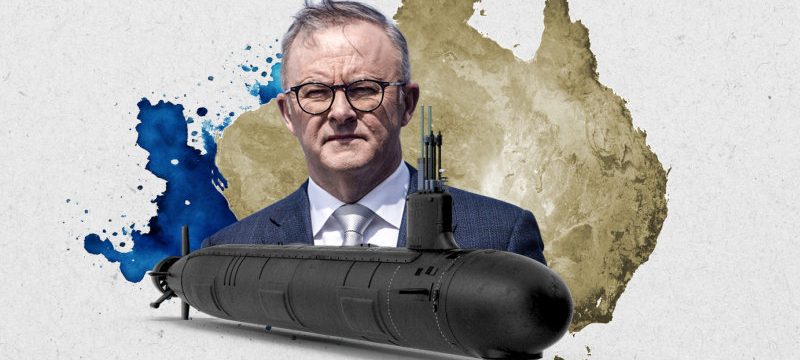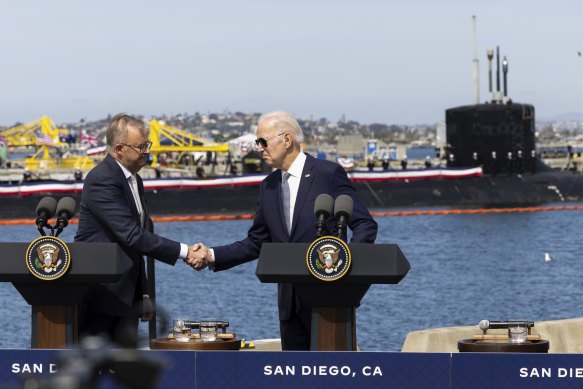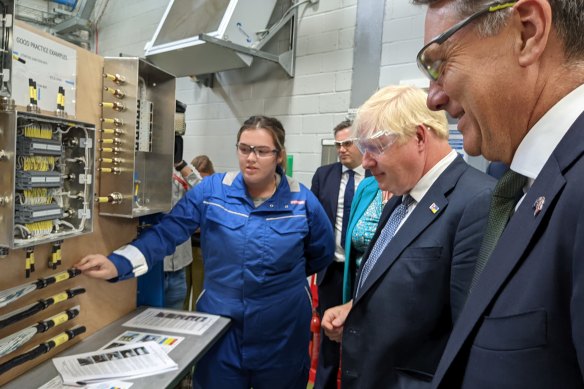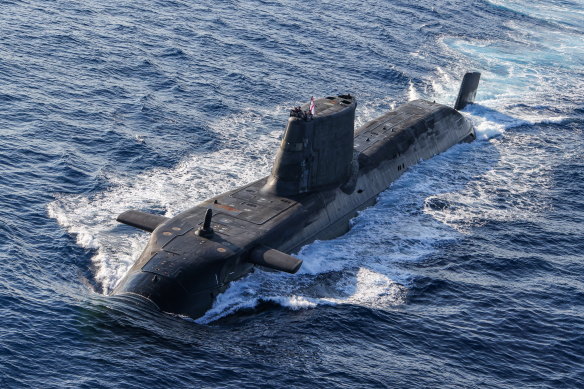By Matthew Knott
In his landmark book Australia’s Defence, which chronicled the nation’s defence policy in the lead-up to the Vietnam War, historian Thomas Millar stressed that “the first point to remember about the Australian island-continent is not that it is a continent but that it is an island”.
It’s a point others have felt the need to make repeatedly since. Almost six decades after Millar’s book was published, retired Army major-general Mick Ryan says Australia continues to lack an “oceanic consciousness”.
“Look at our myths, our stories, our movies,” he says. Think Sidney Nolan’s paintings of Ned Kelly or Peter Weir’s film Picnic at Hanging Rock. “They’re all about the land. They’re not about the ocean, but we’re surrounded by it.”
Prime Minister Anthony Albanese and US President Joe Biden shake hands during the AUKUS announcement.Credit:Alex Ellinghausen
Ryan says this helps explain why the Australian Army has traditionally held pre-eminence among the three military branches, with the Navy and Air Force trailing behind.
If the past week doesn’t change Australians’ deeply ingrained habit of looking inward to the land, rather than outward to the sea, then nothing will.
The nation awoke on Tuesday to learn the government plans to spend between $268 billion and $368 billion over the next 30 years developing a fleet of eight nuclear-powered submarines. Even over a long time frame, it is a staggering amount of money.
Just as the 1980s marked a turning point for the Australian economy – the tearing down of tariff barriers, workplace deregulation, the sale of iconic government assets – the past week represented a new era in Australian defence policy.
Standing at the San Diego Naval Base alongside US President Joe Biden and British Prime Minister Rishi Sunak, Prime Minister Anthony Albanese said: “The scale, complexity, and economic significance of this investment is akin to the creation of the Australian automotive industry in the post-World War II period.”
Only six nations possess nuclear-powered submarines, which are in many ways as technologically sophisticated as space shuttles. Australia will become the seventh within a decade if the most ambitious defence project in its history goes to plan. Such a colossal undertaking will force the country to confront fundamental questions about itself.
Are we foremost a continent or an island? Are we happy to be a plucky middle power in the Asia-Pacific or are our geopolitical ambitions more consequential? How much of the budget should be allocated to the military compared to, say, the National Disability Insurance Scheme or Medicare? Are we too dependent on the United States, or should we hug our closest ally even tighter to keep us safe in an era of great power rivalry?
The past week has seen a rare eruption of bipartisanship, with the Coalition throwing full support behind Labor’s submarine plan (just as Labor did in opposition when Scott Morrison created the AUKUS pact). But the praise has been far from unanimous.
Former prime minister Paul Keating used an incendiary appearance at the National Press Club to describe the submarine plan as the “worst deal in all history”. Why was Australia spending so much on submarines, he asked, when China has no desire or capacity to invade the Australian mainland? In essence, Keating was daring Labor’s base to rise up and demand the government tear up the AUKUS pact.
Defence Minister Richard Marles says the submarine program is being driven by “the biggest conventional military build-up that we have seen since the end of the Second World War” – a clear reference to China. “We need to respond to this,” he said this week. “A failure to do so would see us be condemned by history. As a trading island nation, so much harm can be done to us before ever setting foot upon our shores.”
The nation is dependent on shipping routes for almost all of its imports – including fuel – which makes it highly vulnerable to a blockade that shuts us off from the rest of the world. Marles argues Australia’s interest in promoting free movement throughout the region means we must have submarines that can travel further and faster than our current vessels.
The COVID-19 pandemic required ordinary citizens to become instant amateur epidemiologists, able to distinguish between surface and airborne disease transmission. Similarly, to make an informed judgment about whether Australia is making a wise investment in nuclear-powered submarines requires a familiarity with concepts only naval experts previously needed to consider.
Take snorting. It’s a term Marles only used publicly for the first time this week but is essential to understanding why Australia is investing in such expensive technology.
“Snorting” describes the process by which submarines rise to the surface of the ocean to expel contaminants, replenish their oxygen supplies and recharge batteries. Diesel-powered submarines like Australia’s current Collins-class vessels have to snort regularly to continue to operate. But rapid advances in technology are making even brief “snorts” highly risky. This problem doesn’t apply to nuclear-powered submarines, given their generators don’t need oxygen, allowing them to stay submerged for months at a time and only needing to surface to restock food.
As Peter Dean, a defence expert at the University of Sydney’s United States Studies Centre, explained in a panel session this week: “In a world where there’s increasing intelligence, surveillance and reconnaissance from satellites to sensors in the water, it’s becoming more and more difficult for conventionally powered submarines to be survivable and maintain stealth … Every submariner I’ve ever spoken to in Australia would say if they had a choice they would have a nuclear-powered submarine from a tactical, strategic and operational point of view.”
Albanese justified the huge price tag by saying nuclear-powered submarines are “less detectable, they’re faster, they’re able to stay away from the port for longer” than our current vessels.
“They’re essentially just much, much better,” he said. “And we should acquire assets which best defend our nation.”
No one disputes that the submarines represent a massive leap forward in technology. The question is whether they are a smart use of taxpayer money, how soon they will arrive and whether they make Australia more or less likely to be drawn into a possible war with China, its biggest trading partner.
Defence Minister Richard Marles (right) and then-British PM Boris Johnson talk to Autumn Benson, a first-year-apprentice at BAE Systems, at the company’s submarine shipyards in the British port of Barrow-in-Furness in August last year.Credit:Latika Bourke
A historic step
The United States has transferred its top-secret nuclear-powered submarine technology to just one other nation in its history: the United Kingdom in 1958. Thirty years later, however, another country came close to acquiring the technology, a tale that reveals the many ways such a complicated project can be derailed.
In 1987, the Canadian government announced plans to develop a class of at least 10 nuclear-powered attack submarines because of their speed, range and ability to operate under the Arctic ice. Overruling the advice of senior Navy officers, US president Ronald Reagan announced he supported the transfer of US reactor technology to its northern neighbour.
Technical problems soon emerged: a French-designed submarine proved too noisy and slow, while a rival British-designed vessel didn’t have enough torpedo tubes. Public opposition rose in Canada thanks to a daunting price tag and the view that defence spending should take a back seat following the fall of the Berlin Wall. The project was cancelled in 1989 and Canada never acquired a nuclear-powered submarine.
This is precisely the scenario Keating would like to see play out in Australia. As for Albanese and Marles, it’s the nightmare they are determined to avoid.
There’s a range of views among defence experts, but the reaction to the government’s submarine plan, unveiled on Tuesday, was generally positive. Michael Green, who served as special assistant on national security affairs to president George W. Bush, describes it as a “Goldilocks solution” that will benefit all three member nations and deliver nuclear-powered submarines to Australia faster than anticipated.
Richard Dunley, a naval expert at UNSW, says the plan “looks about as good as you can imagine and better than a lot of us expected”. But the potential for things to go wrong when it is put into practice is unavoidable. “The idea of this being delivered on time and on budget seems highly improbable,” Dunley says.
Three degrees of risk
Like a video game in which players advance through increasingly difficult levels, the submarine plan begins simply and becomes increasingly complex and risky as it goes on.
The first of the three stages is the most foolproof and will begin almost immediately. US and British nuclear-powered submarines will make increased visits to Australia, allowing local submariners to become more familiar with the technology. Beginning in 2027, those submarines will have a rotational presence at HMAS Stirling naval base in Perth. Crucially, these vessels will remain British and American assets; none will be under Australian operational control.
That is scheduled to change when stage two kicks in from 2033. This is the date Australia should obtain the first of its own Virginia-class submarines from the United States. A second Virginia should arrive in 2036 and another in 2039.
The Virginia-class vessels have been in service for two decades and are regarded as the pinnacle of submarine technology. Still, there is risk on multiple levels. American shipyards are currently operating at full capacity; even with billions of dollars in investment from Australia, there is no guarantee they can expand production to meet demand. The US Congress will have to pass amendments to its military export regulations to make the transfer happen.
Then there are the politics. Biden could be out of office in two years and will certainly not be president in a decade. What if Donald Trump, or another isolationist figure, was to enter the White House on an America First platform? They could scrap the offer of Virginia-class vessels at any time, leaving Australia badly exposed. It is for this reason Hugh White, emeritus professor of strategic studies at the Australian National University (ANU), believes there is a 50-50 chance the Virginia-class deal will fall over. The government can only hope White is overly pessimistic, and the current bipartisan goodwill for Australia prevails over coming decades.
In a broader strategic sense, White is more worried about the prospect of the Virginia-class deal succeeding than collapsing. These vessels are so potent and can travel so far, White believes they would guarantee Australia’s participation in a war between Washington and Beijing over Taiwan – a fight he says we should avoid entangling ourselves in.
The third stage of the project is even more difficult and risky. This involves Australia building an entirely new type of submarine – to be known as SSN AUKUS – based on an updated version of the current British Astute-class submarine and featuring American parts. The first SSN AUKUS is scheduled to enter service in the early 2040s, a date that sounds far away but is actually extremely ambitious.
To see how such a project can go awry, look at the Navy’s current efforts to build a fleet of frigates known as the Hunter class. Like the planned AUKUS SSN, the ships are based on a modified British design and will be built at Adelaide’s Osborne shipyards. From 2016 to 2020, the cost of building nine frigates blew out from $30 billion to $45 billion and the project has been beset by delays. In February, an auditor-general report warned they could be outmatched by Australia’s adversaries before they enter the water.
Building a fleet of nuclear-powered submarines is far more complicated. That is why Alan Finkel, Australia’s former chief scientist, questions the wisdom of spending so much money on a capability that could become obsolete when faced with emerging technologies such as autonomous underwater drones. (China is investing in expanding its own fleet of nuclear-powered submarines, suggesting they believe they will be a useful asset for decades to come.)
A British Astute-class nuclear-powered submarine.Credit:Royal Navy
Even with a growing military budget, difficult decisions will have to be made. “In resource terms, AUKUS represents a high-stakes doubling-down on nuclear-powered submarines, and by extension the Navy,” three defence experts from the International Institute for Strategic Studies warned this week. “The Australian Defence Force cannot afford its budget to be eaten by a single capability or armed service, however important.”
Peter Dean, of the United States Studies Centre, says the biggest challenge for Australia can be summed up in three words: “workforce, workforce, workforce”. The military is already short of personnel, including submariners, and thousands of highly skilled defence industry workers will have to be found. Only one university in the nation, UNSW, administers a nuclear engineering degree, while ANU is the only one to educate students in nuclear science, creating a massive workforce training challenge.
The government is looking on the bright side, framing the creation of 20,000 jobs as a boon for the nation. “An apprentice who starts on this project today could work their entire career building these submarines for Australia, which is a tremendous opportunity,” Defence Industry Minister Pat Conroy said this week.
By acquiring nuclear-powered submarines, Australia is confronting the realities of its maritime geography, setting sail on a course that carries both great opportunity and great risk.
Cut through the noise of federal politics with news, views and expert analysis from Jacqueline Maley. Subscribers can sign up to our weekly Inside Politics newsletter here.
Most Viewed in Politics
Source: Read Full Article



